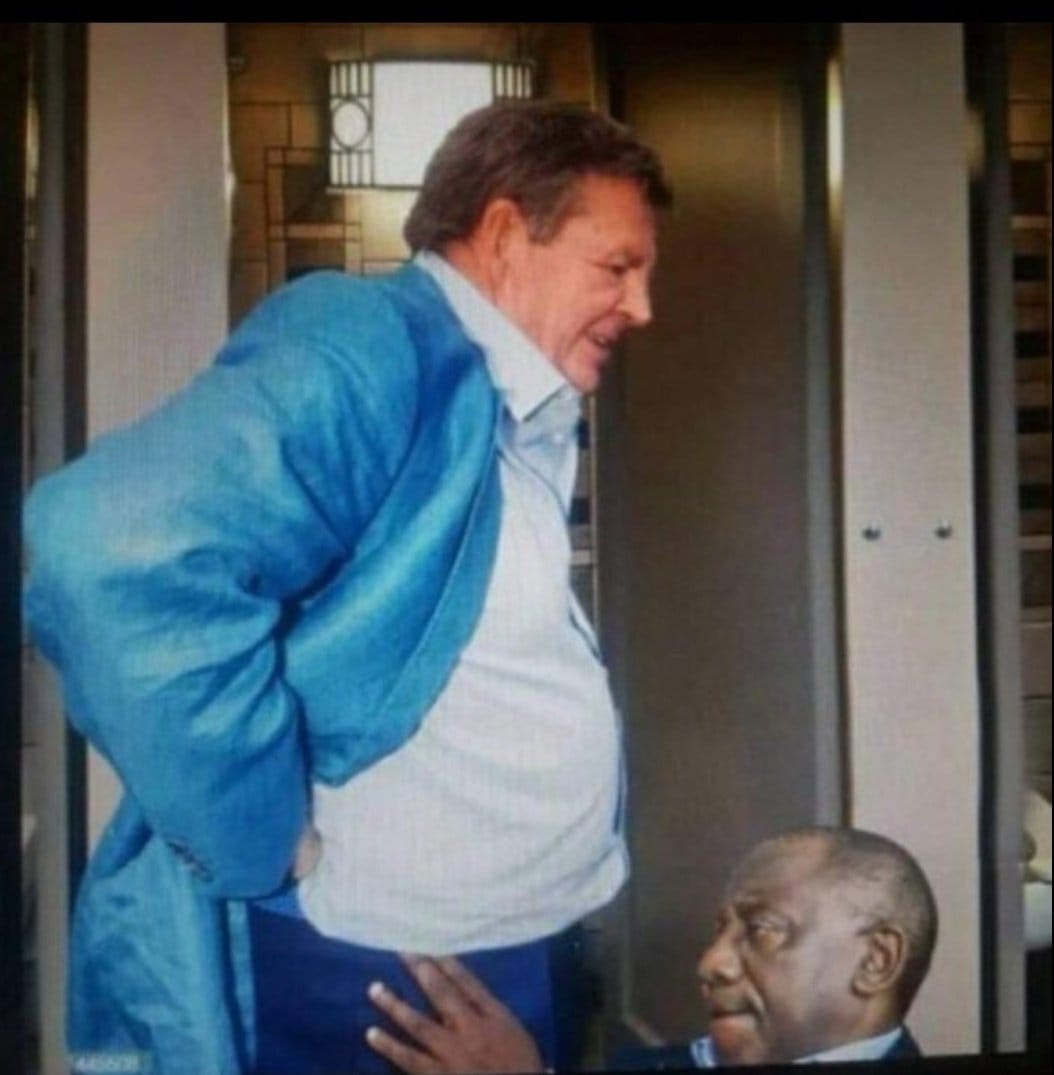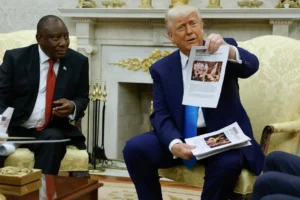
The Emergence of a Controversial Photograph: Implications for South African Leadership and Socio-Economic Dynamics
Abstract
The recent surfacing of a provocative photograph from the early 1990s, depicting President Cyril Ramaphosa in a compromising position with billionaire Johann Rupert, has ignited intense debate across social media platforms. This article examines the potential ramifications of the photograph’s authenticity, considering the historical context of Black Economic Empowerment (BEE) policies, the socio-economic landscape of South Africa, and the current political climate, including tensions involving former U.S. President Donald Trump and local organizations such as AfriForum.
Introduction
In February 2025, a photograph allegedly from the early 1990s emerged on platforms including LinkedIn, Facebook, and X (formerly Twitter). The image portrays Cyril Ramaphosa, now President of South Africa, in a compromising position with Johann Rupert, a prominent South African billionaire. The photograph’s release, purportedly by an intelligence agent, has sparked widespread controversy and raised questions about its authenticity and implications. This article explores the potential consequences if the photograph is genuine, analyzing its impact on historical narratives, current political dynamics, and future socio-economic trajectories in South Africa.
Historical Context: Black Economic Empowerment and Elite Networks
Black Economic Empowerment (BEE) was instituted in South Africa as a policy framework aimed at redressing the economic disparities created by apartheid. The initiative sought to facilitate the participation of Black individuals in the economy through ownership, management, and control of enterprises (Southall, 2006). Cyril Ramaphosa, a key figure in the African National Congress (ANC) and former leader of the National Union of Mineworkers, emerged as a significant beneficiary of BEE policies. Through strategic investments and partnerships, he amassed considerable wealth, exemplifying the rise of a Black capitalist class envisioned by BEE (Iheduru, 2004).
Johann Rupert, heir to the Rembrandt Group, expanded his business empire into various sectors, including luxury goods and banking. While Rupert’s business acumen is well-recognized, his influence has occasionally been a subject of public scrutiny and debate (Southall, 2006).
The alleged photograph, if authentic, could suggest a clandestine relationship between Ramaphosa and Rupert, potentially challenging the perceived integrity of BEE transactions. Such a revelation might imply that BEE, rather than serving as a tool for broad-based empowerment, facilitated the enrichment of a select elite through opaque dealings. This perspective aligns with critiques that BEE has primarily benefited politically connected individuals, leaving systemic inequalities largely unaddressed (Iheduru, 2004).
Implications for Ramaphosa’s Presidency
The emergence of the photograph during Ramaphosa’s tenure as President could have profound political repercussions. His administration has been marred by challenges, including economic stagnation, allegations of corruption, and internal divisions within the ANC. The photograph could exacerbate these issues by:
-
Eroding Public Trust: The image may reinforce perceptions of unethical relationships between political leaders and business magnates, undermining public confidence in Ramaphosa’s commitment to transparency and reform.
-
Fueling Political Opposition: Opposition parties and factions within the ANC could leverage the controversy to challenge Ramaphosa’s leadership, potentially leading to calls for resignation or intensified intra-party conflict.
-
International Relations Strain: The scandal could affect South Africa’s diplomatic standing, particularly in light of recent tensions with the United States. Former President Donald Trump’s administration had criticized South African policies, including land reform and economic empowerment initiatives, leading to strained relations (Financial Times, 2025). The photograph could be utilized by international critics to question the legitimacy of South Africa’s leadership and policies.
Socio-Economic Ramifications
The potential exposure of unethical collaborations between political and business elites may prompt a critical reassessment of South Africa’s socio-economic policies:
-
Reevaluation of BEE Policies: Revelations of misconduct could lead to public demand for a comprehensive review of BEE frameworks to ensure they serve the broader population rather than a privileged few.
-
Economic Uncertainty: The scandal may deter both domestic and foreign investment, as concerns about governance and stability intensify. This could exacerbate existing economic challenges, including high unemployment and inequality.
-
Social Unrest: Perceptions of entrenched corruption and inequality could fuel public protests and civil unrest, particularly among communities that have not benefited from post-apartheid economic policies.
Future Trajectories: Confronting Elite Malfeasance
Addressing the systemic issues highlighted by the photograph’s emergence necessitates a multifaceted approach:
-
Policy Reform: Implementing stricter regulations and oversight mechanisms to ensure that empowerment initiatives are transparent and inclusive.
-
Judicial Accountability: Pursuing legal action against individuals implicated in corrupt practices to restore public trust in governance institutions.
-
Public Engagement: Fostering dialogue between government, civil society, and the private sector to collaboratively develop strategies that promote equitable economic development.
Conclusion
The alleged photograph of President Ramaphosa and Johann Rupert, if authenticated, could serve as a catalyst for significant political and socio-economic upheaval in South Africa. It underscores the imperative for genuine transparency, accountability, and inclusivity in the nation’s leadership and economic policies. Confronting and rectifying the malfeasance of elites is essential for fostering a just and prosperous future for all South Africans.
References
Financial Times. (2025, February 13). South Africa has been blindsided by Donald Trump. https://www.ft.com/content/ef60e887-09d6-499e-88cc-4c020e555010
Iheduru, O. C. (2004). Black economic power and nation-building in post-apartheid South Africa. Journal of Modern African Studies, 42(1), 1-30.
Southall, R. (2006). The logic of black economic empowerment. DIIS Working Paper, 2006/28. https://www.researchgate.net/publication/242



